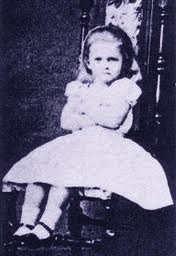 The main problem with Alice is the darkness. It’s not as if this were a recently concocted and Freudianised 20th century difficulty. A key contemporary of Carroll unhesitatingly treated his ‘Wonderland’ text as if it were a tissue of whimsy concealing a substantial and threatening shadowland. Less than two years after Carroll’s ‘golden afternoon’ spent in a boat with Alice Liddell and her sisters, on the 4th of July 1862, the writer was extending the text transcribed from the original storytelling as part of its preparation for publication. He had supplied a number of his own illustrations but was advised to seek a professional draughtsman. The Punch cartoonist and caricaturist John Tenniel was approached to illustrate the work, which was executed in 1865. Carroll sent the illustrator a photograph not of Alice Liddell but another child, Mary Hilton Badcock. Tenniel refused to work with any model however, and, in Carroll’s words, ‘drew several pictures of “Alice” entirely out of proportion – head decidedly too large and feet decidedly too small.’
The main problem with Alice is the darkness. It’s not as if this were a recently concocted and Freudianised 20th century difficulty. A key contemporary of Carroll unhesitatingly treated his ‘Wonderland’ text as if it were a tissue of whimsy concealing a substantial and threatening shadowland. Less than two years after Carroll’s ‘golden afternoon’ spent in a boat with Alice Liddell and her sisters, on the 4th of July 1862, the writer was extending the text transcribed from the original storytelling as part of its preparation for publication. He had supplied a number of his own illustrations but was advised to seek a professional draughtsman. The Punch cartoonist and caricaturist John Tenniel was approached to illustrate the work, which was executed in 1865. Carroll sent the illustrator a photograph not of Alice Liddell but another child, Mary Hilton Badcock. Tenniel refused to work with any model however, and, in Carroll’s words, ‘drew several pictures of “Alice” entirely out of proportion – head decidedly too large and feet decidedly too small.’
Tenniel’s distinctive sense of proportion was not confined to his renderings of the dreamchild. The cartoonist stripped the language of dream of its sunshine and imposed the shifty, shifting, scratchy and shadowy crosshatch that would unsettle nursery-dwellers for the next century and a half. Sloughs of febrile gloom and maniacal despond provide the dark ground upon which Carroll’s’s lighter fancy comes to rest, profiting greatly from the interplay with its shadow, so insistently conjured by the illustrator.
But is the darkness actually there? Without Tenniel would the tales not be delightful blossoms of absurdity no more taxing than the drift of a rowing boat along the upper reaches of the Thames? The short answer is that the tales are bristling with invitations to explore the abyssal depths but these latter are consistently overlooked in favour of jolliness. Tenniel reversed this trend, reacting as though a surface sweetness was to be expected then brusquely swept aside.
Notwithstanding the purportedly ‘factual’ yet debatable view that Carroll’s preoccupation with pre-pubescent girls constituted a perversion, this possibility was not the one so firmly taken up by Tenniel. It is more likely that the illustrator recognised, in the subterranean location and disjointed narratives of Wonderland, a territory that was not just quaintly engaging but psychologically rich and therefore deserving of the imagery of nightdream rather than daydream. Some decades later the Surrealists would come to a similar conclusion.

The invitation to the land of light, child-pleasing enchantment has been declined on a small number of occasions in the course of the history of the adaptation and illustration of ‘Alice’. In 1985 Gavin Millar directed ‘Dreamchild’, a film about Alice Liddell’s relationship with Carroll/Dodgson. The screenplay, by Dennis Potter, focused on the reminiscences and insights of 80 year old Alice Hargreaves, née Liddell, as she travelled to New York in 1932 to attend Carroll’s centenary celebrations. The film moves between Alice’s American experiences of being a celebrity, her recollections of her intense friendship with the author of the Alice books and hallucinated encounters with the creatures from the stories. The latter are fine examples of cable-control puppeteering, a pre-animatronic technology, constructed by Jim Henson’s Creature Shop and featuring the Gryphon, the Mock Turtle, the Mad Hatter, the Dormouse, the Caterpillar, and the March Hare. The creatures are crabby, shrill and unkempt. Those with teeth have yellowed fangs and those with skin have livid, blotchy skin.

The lack of whimsy in the film is, more importantly, not restricted to those denizens of Wonderland who are ordinarily portrayed as wacky and cuddlesome. As Alice finds her long forgotten or suppressed memories of Carroll returning, the film dares to raise, quite tastefully, the possibility that Carroll was passionately in love with Alice Liddell. Ian Holm’s portrayal of Dodgson/Carroll elicits our sympathy with the author and helps us to be reassured that his inclinations were in some sense ‘innocent’ and never actually enacted. The film moves beyond this widely held view, however, when it examines the impact on young Alice, as recalled by the octogenarian Mrs Hargreaves, who is seen to be haunted if not permanently marked by the experience of her girlhood exposure to the pressure of an adult’s amorous attentions.
24.05.2011
[/et_pb_text][/et_pb_column][/et_pb_row][/et_pb_section]

